Floor in the hallway: features, types and tips for choosing

The hallway should make a good impression. Not every visitor enters the apartment and has the opportunity to appreciate its interior, so he takes with him the idea of the owners, casting a glance at the hallway.
The floor in the corridor is designed in accordance with the style of the rest of the furnishings. But we should not forget that this is the only room in which we walk in street shoes, often bringing traces of rain and mud on them. Therefore, it is better if the floor covering is moisture-resistant and dirt-repellent.

Floor covering requirements
There are special requirements for flooring in the hallway:
- it must be resistant to abrasion;
- have water-repellent properties;
- resistant to dirt and easy to clean;
- be durable, resistant to mechanical stress, especially if the family has pets;
- be durable;
- look beautiful and match the overall design of the hallway.






Materials (edit)
The strength and service life of the floor depends on the coating material. To make a choice, you need to consider the features of each type, evaluate its pros and cons.

Laminate
A beautiful modern coating, assembled from several layers: chipboard boards, a paper base with a printed pattern, and a durable polymer layer.
Laminate is divided into classes, and the higher this value, the thicker the polyurethane protection and the higher the degree of its wear resistance. Some users believe that the use of class 21, 22, 23 is sufficient for apartment conditions, and there is no point in overpaying for more durable products. But another opinion should also be taken into account, which draws attention to the specifics of the hallway. In order for the floor to serve for at least 15 years, it is better to pay more and purchase a laminate of class 31 and higher.


One of the requirements for the floor in the hallway is providing moisture resistance. Laminate flooring absorbs moisture at the joints, therefore it is better to choose products with chamfers. For greater reliability, you can walk along the seams with mastic and wax.
The coating itself is almost indistinguishable from a wooden floor, it repeats the pattern and color of the tree. Laminate does not need an adhesive base, it is laid on a substrate and fastened with locks, which allows you to mount it yourself, without the participation of a specialist. Dismantling and replacing an old coating is as easy as laying a new one.

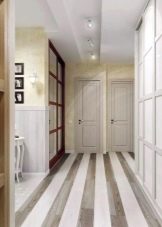


When working with laminate, a small nuance should be taken into account: the seams become invisible if they are displayed parallel to the light source (window or artificial lighting).
Parquet and parquet board
Expensive parquet made from solid wood is irrational to lay in the hallway. Moisture and dirt from the street, as well as increased stress, have a bad effect on varnished wood surfaces. Parquet is used if the hallway wants to give an expensive respectable look. In this case, the floor will have to be more carefully looked after, periodically restored and often covered with a new layer of varnish.
Parquet board is not made of solid wood, it consists of several layers of different types of wood. Inexpensive conifers are taken as a basis, and the upper part is covered with veneer of expensive hard varieties, which determine a wide variety of colors and patterns of this product.
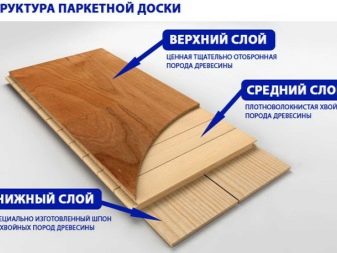



Porcelain stoneware and ceramic tiles
Both products are made from clay, but the technology of their manufacture is somewhat different. Porcelain stoneware acquires greater strength, and therefore costs more. Both materials reliable and durable, not afraid of dirt, moisture, resistant to mechanical stress. Resistant reaction to aggressive chemical environment makes them easy to care for.
Ceramic materials have different textures, colors and patterns, they can imitate wood parquet, natural stone and other surfaces. For the hallway, it is better to choose special non-slip materials. Due to the cost of porcelain stoneware and the complexity of its installation, many people prefer to lay linoleum or laminate in an apartment. But if you look from the other side, a little material is required in the hallway, the costs for it will be small, and the strength and durability of the coating is guaranteed.




In spacious rooms, you can use a combined floor and a stone area can be organized only at the front door, where the bulk of the dirt from the street gets.
Linoleum
This type of coating is one of the most inexpensive. It is mistakenly considered short-lived. In fact, it is divided into a number of categories, and only one type (household) does not last long - about 5 years. If you lay a semi-commercial product, you can not think about replacing the floor covering for 10 years. Commercial linoleum will last at least 25 years. The cost of coverage increases in proportion to the category.
The coatings differ not only in thickness and density: the pattern on a commercial product is penetrated to its full thickness, and on a household and semi-commercial product - only on the top layer. In addition, expensive linoleum has a strong and durable polyurethane coating. It is used in public places and with high traffic of people.




In order to save money, the floor in the apartment can be covered with household or semi-commercial material.
The linoleum coating fits seamlessly onto the floor and is easy to maintain... A wide range of options allows you to match it to any modern interiors. The disadvantages of the coating include the artificial origin of the material. It has a certain toughness, but it can still be scratched and cut.

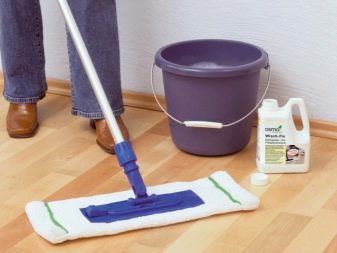
Carpet
Not the best choice for a hallway. Precipitation and dirt brought from the street are difficult to remove from such a coating. But if there is a need for a soft floor covering, it is better to give preference to artificial options based on nylon, polypropylene, acrylic and other synthetic threads. They are easier to clean, they do not rot from dampness, do not sag and do not change shape, as is the case with a natural carpet made of woolen threads.
In addition, artificial material will cost less and last longer. You should pay attention to the fabric method of weaving threads. It is more reliable than the so-called needle-punched one. The carpet is sold in rolls and is installed seamlessly. But there is another type of product - carpet tiles, which are much easier to install due to their small size.

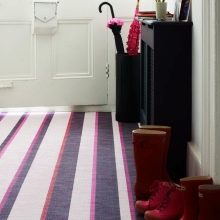

Self-leveling floor
An amazing finish that can use any kind of art print. Particularly impressive are the 3-D drawings, which realistically depict an abyss underfoot, a river, green grass and other spectacular images. The picture is under a thick layer of polymer, so does not wear out or fade. The coating itself is very dense, it cannot be pushed through with a shoe pin or scratched with furniture.


Such a floor is not afraid of leaks, it will hold water on itself until it is removed.
Color solutions
Color significantly affects the perception of the environment. With its help, you can correct the not very good geometry of the room. For example, a long narrow corridor will visually expand if a light-colored laminate is laid perpendicular to the elongated walls. In such a situation, light linoleum or carpet with a transverse pattern will also help. Small dark hallways especially need a light covering. Beige, sand, cream color will not only refresh the room, against their background dust and dirt will be almost invisible. The dark coating, on the other hand, shows dust on its surface.



A noble-neutral gray tone is used if you need to emphasize beautiful furniture, wallpaper or design. All shades of light brown that do not attract attention will cope with this task.

Combined floors often have completely different color palettes. For example, at the front door, ceramic tiles can match the tint of the walls, and dark laminate flooring can match the tone of the furniture.

If the color of the floor, walls and furniture in the hallway is the same, then in order to revive the situation, you should make several bright accents in the form of a rug or decor.
Design options
The entrance hall is the face of the apartment, and guests get their first impression of its tenants right at the entrance. When making repairs in the house, you should not treat the hall as a leftover principle. A good hallway, even small in size, has its own style, which should be followed when working with the interior. Here are some design options as examples.
- Floor in style country simulates a rough board in various sizes and colors. Homespun rugs become his decoration.

- Patchwork tile makes the corridor in rustic attractive and cozy style.


- In the direction country use tiles depicting cracks and chips, as if it had lain here for a century.
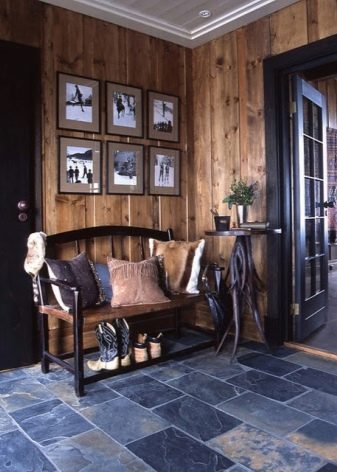
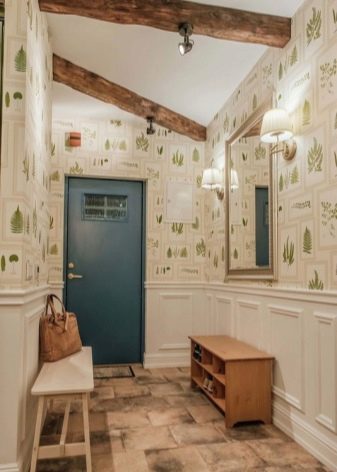
- Mosaic on the floor towards baroque not often found even in artsy interiors.


- Combined floor in the interior high tech. At the entrance there is a moisture-resistant tile, and closer to the rooms - a beautiful strict laminate.


- Classic hallway in a contrasting design. The floor is covered with a glossy black slab combined with ivory tiles.

- Elegant entryway in style provence. The light wood finish maintains the comfort of the surroundings.


Selection recommendations
The choice of floor covering for the hallway should depend not only on the taste of the owners, but also on many other factors.
- It is important to consider the style of the interior. Historical and rural areas are incompatible with artificial materials such as linoleum.
- The color of the floor affects the size and shape of the room.
- The place in the hallway, which is stepped on in street shoes, should be water-repellent and color that masks dirt.
- The choice of material is influenced by its cost. The most affordable type of coating is linoleum.
- If the surface has pronounced irregularities, a self-leveling coating will help to hide them. With the help of 3D graphics, you can get the most extraordinary floor.
- Those who love closeness to nature and will not stand up for the price can choose wood, as well as natural marble floor or travertine flooring.
- Practical people would prefer to put a combination floor that solves different tasks in the same room.
- Most consumers still prefer to lay laminate flooring. It has a loyal value, beautiful appearance, almost does not differ from wood coating. If you choose a higher class, the floor will last for many years.




Interesting examples
If you are not sure about the choice of material for covering the floor in the hallway, you can familiarize yourself with beautiful examples, they provide fresh ideas and inspiration for creating your own unique interior.
- Warm, environmentally friendly cork floor in different shades of brown, artistically designed. A low, contoured podium accentuates the beauty of the pavement.

- With the help of a contrasting laminate, you can fulfill any of your fantasies.

- The combined floor is easy to organize even in the smallest hallway: boots are removed on the tiles, and in slippers they walk along the laminate.
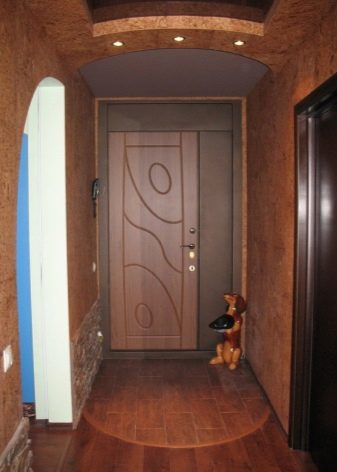

- An incredible flight of imagination is carried out using a self-leveling floor. Bringing the dwelling closer to nature, in the corridor you can make a path made of stone surrounded by overgrown grass.

- With the help of a self-leveling coating, you can depict a hole in the floor with a wobbly unreliable bridge. Guests are unlikely to forget such an interior.

- An example of a beautiful art parquet.

The choice of flooring in the hallway should be taken seriously, it should not only delight with its appearance, but also be practical, combined with the decoration and furniture in the room.
For information on how to choose a floor covering, see the next video.


For our hallway, a parquet board is optimal.